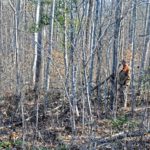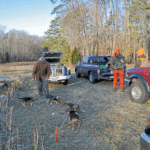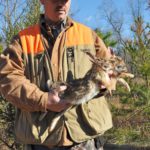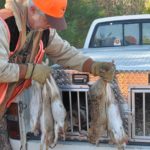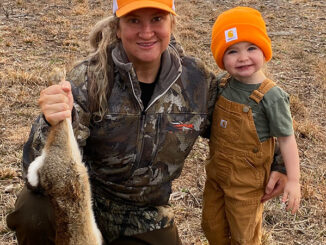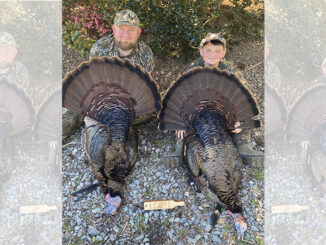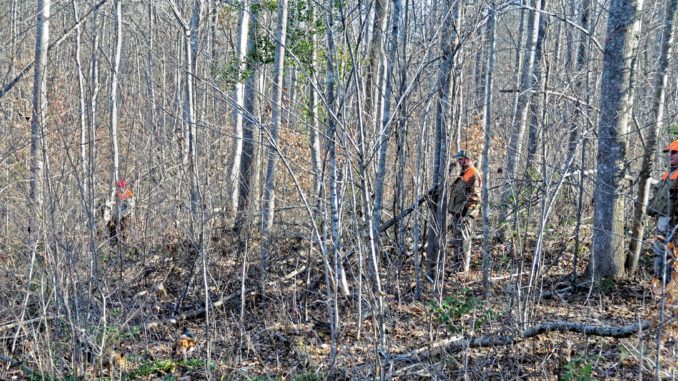
‘The Quarter’ at Saxapahaw provides plenty of fun after deer season ends.
Alston Quarter is a wild section of land — a half-mile by a half-mile — in Alamance County known to locals as “Austin Quarter” that’s been called “The Quarter” since the 1700s.
Near Saxapahaw and now part of a 1,000-acre tract — of 3,025 acres originally granted to John Porter by patent on Nov. 12, 1728 — The Quarter is bounded by the Haw River and Cane Creek. It’s the single-largest contiguous tract of land in the county.
A group of local sportsmen, including Jim Copland, president of Haw River’s Copland Fabrics and chairman/director of Mid-Carolina Bank, lease hunting rights on the land from the owners, the Cameron Trust of Wilmington.
“Mostly, it’s for deer hunting,” said Copland. “We kill some good deer down there, but there’s another kind of hunting I enjoy.”
When deer season ends Jan. 1 each year, Copland invites local and non-local rabbit hunters to bring their packs of beagles to The Quarter each Saturday — or at least during cold-weather Saturdays — to chase cottontails and sometimes a swamp rabbit or three.
The habitat at The Quarter couldn’t be better for producing loads of rabbits and action for some of the best beagle packs and top rabbit hunters in the region.
“We’ve got lots of cutover land that’s in new growth,” said Copland, 69. “There are thickets, new pine-plantation areas that’ve been clearcut and re-planted with pines — giving rabbits cover from hawks and owls, foxes and coyotes — open hardwoods, fields and plenty for (rabbits) to eat.”
Two of the local hunters Copland invites include Chris Kidd, a maintenance supervisor at the Kernodle Center, the county’s major medical center, and Eric White, both of whom have top-notch beagle packs. Copland allows Kidd and White to bring their rabbit-hunting buddies, some of them who own beagles. They include Cale Rogers, Butch Simmons, Joel Witherow, Jordan Simmons, Danny Ray and Ryan White, Eric’s son.
Other beaglers also attend the hunts include the famed Harold Langdon, owner of Hillcrest Hounds of Smithfield, Va., one of Old Dominion’s top trainers.
“We went twice to The Quarter a couple years ago with Mr. Copland, had five dogs and killed 30 rabbits in two days,” Kidd said.
Kidd and his wife, Anita, moved to Alamance County from LaCrosse, Va., in 1993, and he immediately began looking for good places to hunt and also wanted to start his own beagle pack.
“I’d been a rabbit hunter since I was 10 years old,” Kidd said, “so I really had a good time growing up because there are lots of rabbits in Virginia. But (Austin Quarter) is the best place I’ve ever hunted for rabbits in North Carolina, and I hope Mr. Copland continues to invite us to hunt with him.”
Kidd met White, a state elevator inspector, in 1996.
“I didn’t have any dogs after I moved to North Carolina, but me and Eric got to talking at work, and he invited me to go rabbit hunting up near his home in Caswell County,” Kidd said. “He had only three dogs, and the first two times we went hunting, we didn’t kill a rabbit.”
Kidd expressed a desire to start a pack of beagles, and White graciously gave him a beagle that spring after one of White’s female dogs had a litter of puppies.
“Counting one dog at Eric’s house, I have five beagles,” Kidd said. “My first two beagles I got from Eric I named Pete and Delmer from two characters in the movie, O Brother, Where Art Thou? and we say our dogs are from Soggy Bottom Kennels.”
Kidd’s and White’s rabbit dogs are the 13-inch variety, the shortest kind. Other beagles measure 15 inches to the tops of their heads.
“I like smaller dogs because they can get into thick stuff, burrow in briars and thickets better than bigger dogs,” Kidd said. “The 13-inch dogs also are faster than the bigger dogs, and I’m one of those rabbit hunters who prefers speedy beagles.”
Kidd said he really didn’t have a preference, “but that’s all we hunt. All our dogs are the same size.
“I really don’t think they’re any better at smelling a rabbit and trailing him, but I think they’re speedier, and 13-inch dogs are good for getting into real thick stuff and bumping out rabbits. They can just get down smaller, in my opinion, and get into good places, places that hold rabbits that might be too tough for a 15-inch beagle to navigate well.”
Kidd said as far as he was concerned, he didn’t have any secrets for finding a good rabbit beagle. That result, he said, is mostly just a luck-of-the-draw deal.
“It’s hard to tell (a beagle’s hunting instincts),” Kidd said. “Hopefully, when you buy a beagle off somebody, it’s got a good bloodline. Then the dog might have a chance to become a good to excellent rabbit dog.”
Practice is the main ingredient in producing an effective rabbit dog.
“Although each dog has his own characteristics, the only thing that makes ’em is getting ’em outside, running ’em and hunting ’em,” Kidd said.
“If you can get two hunting seasons under a dog, you’ll get ’em broke off deer. It takes two good seasons of finding lots of rabbits, and then they’ll start to feel pretty comfortable when you turn ’em out.”
Kidd added that one other condition helps produce an outstanding bunny tracker — a practice pen.
“When they get between three and four months old, we turn ’em out in a running pen with older dogs,” he said.
A running pen is an area of several acres with good rabbit habitat, enclosed by an impenetrable fence to keep the bunnies in and predators, such as foxes and coyotes out. The owners release box-trapped wild rabbits, and the pens supply a good training ground, especially for young dogs.
“The young dogs will start staying around the older dogs and get to running rabbits with them,” Kidd said. “We slowly introduce them to the place.”
If the dogs have picked up quickly on how to sniff, trail and bawl at a rabbit, they may be ready to release in a real hunting scenario very early.
“If they’re doing good at four months, we’ve hunted with a pack as young as seven months old,” Kidd said. “If they’re a bunch of good dogs, they’ll pick up trailin’ rabbits in a hurry, but you have to work with ’em.
“Once they catch on, it’s like turning a light switch on. Once they get the full idea of what they’re supposed to do, they’re gone with it.”
Master beagle trainer Langdon calls this approach “getting set on rabbits.”
“You just take a dog out of (a pen) and put it with two older dogs at first, and pretty soon, he’ll learn what to do,” he said.
Beagles have several problems to overcome in learning how to put a rabbit on the run, then staying with the jumped rabbit.
• Staying on the trail. First, anyplace where there’s one rabbit, there’ll be others. They move around almost constantly, so trails get crossed and intercrossed by several rabbits.
A good rabbit beagle will be able to distinguish the “hot” track of a jumped rabbit versus the scent of an older trail. If the lead dog pursues the old trail, he’ll be on a fruitless chase that won’t push a rabbit past a hunter.
“You always want a beagle to push a hot rabbit trail, not a cold one,” Kidd said.
Technically, the term is “line control” — that is, a beagle or beagles “hold the line” of a hot rabbit trail and won’t become distracted by deer tracts or older bunny trails.
• Figuring out rabbit tricks.
A favorite technique of an older, wiser rabbit is to “double back” on a trail if it’s able to put some distance between itself and the beagles. It then runs in the same path, only back toward the dogs, then makes a giant leap to the side and sits perfectly still while the pack of beagles races past its hiding place. When the dogs come to the end of the hot trail several yards away and begin to mill around — and this is evident because they’ll only bark now and then in frustration — the rabbit will bound away in another direction.
Beagles learn to solve this problem in a running pen by circling until they pick up the trail where the cottontail sat while they passed. At a field trial, when a beagle circles and rediscovers a bunny’s trail, a judge will put a “check” on his scoresheet. Handlers call a beagle that’s good at finding a lost trail a “check dog.”
If beagles chase a swamp rabbit (often called canecutters or bluetails), the rabbit’s first avoidance measure is to head for water. In that case, the dogs often will lose the scent trail because most beagles are reluctant to cross a creek or bigger stream — unless they’ve learned to do that in a pen.
But Langdon said it’s not necessary to have beagles that will meet these criteria absolutely before he takes them hunting.
“I’ve had dogs that were good, but not good enough for field trials,” he said. “They would run over the line, but you could kill a lot of rabbits with them.”
“Some dogs have stronger noses than others,” Kidd said. “Some will pick up a rabbit’s trail and you might start training them a little earlier than other dogs. They won’t bark until other dogs bark.
“Often these dogs you won’t hear when (the pack) loses a rabbit’s trail. They’ll start barking again when the check dog picks up the trail and he starts barking. Then the others will chime in, and they’ll get on the trail again.”

